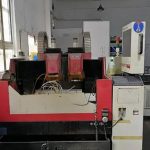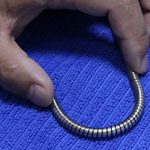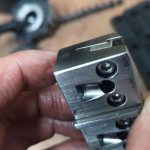Deprecated: get_settings is deprecated since version 2.1.0! Use get_option() instead. in /www/sites/alloy.wiki/index/wp-includes/functions.php on line 4862
Fasteners are a general term for a type of mechanical parts used when two or more parts (or components) are fastened and connected into a whole. They are also called standard parts on the market.

Type of standard parts
It usually includes the following 12 types of parts:
- Bolt: A type of fastener consisting of a head and a screw (a cylinder with external threads), which needs to be matched with a nut to fasten and connect two parts with through holes. This connection form is called bolt connection. If the nut is unscrewed from the bolt, the two parts can be separated, so the bolt connection is a detachable connection.
- Stud: There is no head, only a type of fastener with external threads at both ends. When connecting, one end of it must be screwed into a part with an internal threaded hole, the other end must pass through a part with a through hole, and then screw on a nut, even if the two parts are tightly connected as a whole. This type of connection is called a stud connection, and it is also a detachable connection. It is mainly used in occasions where one of the parts to be connected has a large thickness and requires a compact structure, or where bolt connection is not suitable due to frequent disassembly.
- Screw: It is also a type of fastener consisting of a head and a screw rod. It can be divided into three categories according to its use: machine screws, set screws and special purpose screws. Machine screws are mainly used for a fastened connection between a part with a fixed threaded hole and a part with a through hole, without the need for nut cooperation (this connection form is called a screw connection, which is also a detachable connection; it can also be used with a nut for a fast connection between two parts with through holes.) Set screws are mainly used to fix the relative position between two parts. Special-purpose screws, such as ring screws, are used for lifting parts.
- Nuts: with internal threaded holes, generally in the shape of a flat hexagonal column, and also in the shape of a flat square column or flat cylinder, used to fasten and connect two parts with bolts, studs or machine screws to make them a whole.
- Self-tapping screws: Similar to machine screws, but the thread on the screw rod is a special thread for self-tapping screws. It is used to fasten and connect two thin metal components to make them a whole. A small hole needs to be made on the component. Since this screw has high hardness, it can be directly screwed into the hole of the component to form a corresponding internal thread in the component. This connection form is also a detachable connection.
- Wood screw: It is also similar to machine screw, but the thread on the screw rod is a special thread for wood screw, which can be directly screwed into a wooden component (or part), and is used to fasten a metal (or non-metal) part with a through hole to a wooden component. This connection is also a detachable connection.
- Washer: A type of fastener in the shape of an oblate ring. Placed between the supporting surface of the bolt, screw or nut and the surface of the connected part, it plays the role of increasing the contact surface area of the connected part, reducing the pressure per unit area and protecting the surface of the connected part from being damaged; another type of elastic washer can also prevent the nut from loosening.
- Retaining ring: It is installed in the shaft groove or hole groove of the machine and equipment, and plays a role in preventing the parts on the shaft or hole from moving left and right.
- Pins: Mainly used for parts positioning, some can also be used for connecting parts, fixing parts, transmitting power or locking other fasteners.
- Rivet: A type of fastener consisting of a head and a shank, used to fasten and connect two parts (or components) with through holes to make them a whole. This form of connection is called a rivet connection, or riveted for short. genus with non-detachable connection. Because to separate the two parts connected together, the rivets on the parts must be broken.
- Assemblies and connection pairs: Assemblies refer to a type of fastener supplied in combination, such as a combination of a certain machine screw (or bolt, self-supplied screw) and a flat washer (or spring washer, lock washer); a connection pair refers to a type of fastener that is supplied in combination with a special bolt, nut and washer, such as a connection pair of high-strength large hexagon head bolts for steel structures.
- Welding stud: Due to the heterogeneous fastener composed of light energy and nail head (or no nail head), it is fixedly connected to a part (or component) by welding method, so as to connect with other parts.
Standards for fastener product dimensions
Each fastener product involves some standards in several aspects:
Specifically stipulate the content of the basic dimensions of the product; for products with threads, it also includes the basic dimensions of the thread, the end of the thread, the shoulder distance, the undercut and chamfer, the end dimensions of the externally threaded parts, etc.
Standards for technical conditions of fastener products
Specifically, the standards include the following aspects:
- a) Standards for fastener product tolerances: specify the product size tolerances and shape and position tolerances.
- b) Standards for the mechanical performance of fastener products: specify the marking method of the mechanical performance grade of the product and the content of mechanical performance items and requirements; for some fastener products, this content is changed to the content of product material performance or work performance.
- c) Standards for surface defects of fastener products: specify the types and specific requirements of product surface defects.
- d) Standards for surface treatment of fastener products: specify the types and specific requirements of product surface treatment.
- e) Standards for fastener product testing: specifically specify the content of the above-mentioned various performance requirements for testing.
Standards for acceptance inspection, marking and packaging of fastener products
Specifically stipulate the qualified quality level and sampling plan of the random inspection items when the product is inspected and accepted at the factory, as well as the content of the product marking method and packaging requirements.
Standards for marking methods of fastener products
Specifically stipulate the content of the complete labeling method and the simplified labeling method of the product.
Standards for other aspects of fasteners
Such as fastener terminology Fasteners ISO Standards, fastener product weight standards, etc.
- Standard (commonly used are German standard and American standard)
- GB (national standard) ISO (international standard)
- DIN (German system) JIS (Japanese standard)
- ANSI /ASME (American National Standards Institute – ANSI; American Society Of Mechanical Engineers – ASME) (American Standard)
- BS (British) IFI = Industrial Fastener Institute is the standard of the American Industrial Fastener Association BA (British)
- 2 threads
- M. MF (metric thread)
- UNC. (American Coarse)
- UNF (American Fine Thread)
- UNEF (U.S. Superfine Thread)
- B.S.W. Standard Whitworth Coarse Thread, General Purpose Cylindrical Thread (British Thread)
- B.S.F. Standard Whitworth Fine Thread, General Purpose Cylindrical Thread (British Thread)
- fine pitch thread
- full thread full thread
- 3 screw head type
- IHH=ind hex head saw hex head
- PH=phillips cross recess
- Pan round head (pan head)
- Oval countersunk head
- H.W.H.. Hexagon small flange
- H.W.F. Hexagon large flange
- CSK salad head (sunk head)
- Large wafer large flat head
- Bugle speaker head
- Truss pan head with cushion
- Pozi Metric Slot
- Serra-tion cushion with flowers
- Flower Head
- 6-bobes recess
- Cup head
- 4 Common fastener names
- split washer spring washer (general manufacturers will call the washer “washer”)
- flat washer
- Self tapping screwSelf tapping screw
- Self drilling screw self drilling screw
- drywall screw drywall screw / drywall screw / wall screw
- high low screw high and low screw
- collated screw chain belt screw
- Concrete screw Concrete screw
- Tri-lobular thread Taptite Screw
- kep nut lock nut
- acorn nut acorn nut
- wing washer
- eye bolt eye bolt (also known as eye bolt, in fact, there are many names for this, probably because of different regions)
- Piston bolt Piston screw
- Winding bolt coil screw
- Hexagon head bolts Hexagon head bolts
- Hexagon flange bolts Hexagon flange bolts
- Carriage bolt Carriage bolt
- Square head boltSquare head bolts
- Flat countersink square neck bolts Countersunk square neck bolts
- Flat counter sunk nib bolts
- Cross recessed pan head tapping screws
(If you see # 2 or # 20 on the drawing, it means the head of the screw is suitable for a No. 2 or No. 20 screwdriver) - 5 surface treatment
- BO=black oxide oxidation blackening (if only black is marked, it refers to blackening treatment)
- Zinc plated Galvanized
- cementation carburizing
- nylon patch (When I first saw it, it was directly translated as “nylon patch” literally. When I showed it to the manager, the manager looked at the drawings for a long time and told me that you should check the English of Nailuo, and sure enough —)
- 6 Marks that may appear on other drawings
- Thread diameter: Major Diam
- Middle diameter: Pitch diam
- Bottom diameter: Minor diam
- Go-stop gauge: Go/No go gage
- Mechanical properties: mechanical and physical properties
- unified thread Unified British thread
- Lustrate hydrogen after galvanizing to avoid hydrogen embrittlement
- Case carburization surface carburization
- With across flats
- With across corners
- Radius of fillet: Fillet under the head
- Transition thread length excessive thread
- Wrenching height Wrenching height
- Rockwell Chrome hardness
- Vickers hardness
- Brinell Brinell hardness
- Metallography microscope Metallography microscope
- Salt spray device Salt spray test chamber
- Tensile testing machine Tensile testing machine
- Cold forming
- Hot forging red upsetting
- P C 8 = property class 8 mechanical performance level 8
- Raw material: Raw material
- Spheroidizing annealing: Annealing
- Cold drawing: Drawing
- Cold heading: Forming
- Machining: Machining
- Thread forming: Roll Threading
- Heat treatment: heat-treatment
- Surface treatment: finished
- Dehydrogenation: Lustrating hydrogen
- Inspection: Inspection
- Packing: Packing
- Storage: Stocking
- Lathe: lathe
- Grinding: grinding
- Red hit: hot forging
- stamping: punching
- 7 customs code
- 73181500 Bolt
- 73181600 Nut
- 73182100 Gasket
- 73181100 lag taptite screw
- 73182300 rivets
- 73181400 Self-tapping screws
- 73182400 pin and cotter pin
- The code, name and standard number of foreign common inch thread
- Mark code Name (or purpose) Country Standard number Remarks
- B.S.W. Standard Whitworth Coarse Thread, General Purpose Cylindrical Thread British Standard
- BS84 Inch thread with profile angle 55°
- B.S.F. Standard Whitworth fine thread, cylindrical thread for general purpose
- Whit.S Additional Whitworth Selectable Series, General Purpose Cylindrical Thread
- Non-standard thread for Whitworth profile
- UN Unified Thread of the Constant Pitch Series American Standard
- Internal and external threads of ANSIB1.1 standard tooth type (the bottom of the tooth is flat or randomly rounded)
- Unified thread of the UNC coarse pitch series
- Unified thread of the UNF fine pitch series
- Unified thread of the UNEF extra fine thread series
- UNS① Unified thread of special series
- UNR Unified thread of arc root constant pitch series UNR, UNRC, UNRF,
- UNREF and UNRS are only used for external threads but not internal threads
- UNRC Coarse tooth series unified thread with arc root
- UNRF Unified thread with arc-shaped root and fine thread series
- UNREF arc root ultra-fine thread series unified thread
- UNRS arc root special series unified thread
- NPT② Taper pipe thread for general purpose American standard
- ANSIB1.20.1 British pipe thread with tooth profile angle of 60°
- Straight Pipe Threads for NPSC Fittings
- Taper pipe thread for NPTR pilot rod connection
- NPSM straight pipe thread for mechanical connections
- Straight pipe thread for NPSL lock nuts
- Straight pipe thread for NPSH hose connections
- NPTF Dry Seal Standard Taper Pipe Thread American Standard
- ANSIB1.20.3 Type I
- PTF-SAE SHORT dry seal short tapered pipe thread type Ⅱ
- NPSF dry seal standard fuel oil straight pipe internal thread type Ⅲ
- NPS1 dry seal standard type general use straight pipe internal thread type Ⅳ
ACME③ Trapezoidal thread for general purpose American standard - ANSIB1.5
Inch transmission thread with profile angle 29°
- ①Dimensions and Tolerances All diameter and pitch combinations outside the standard series calculated using the same formula as the standard series.
- ② my country’s 60° conical pipe thread GB/T12716-1991 is equivalent to it.
- ③ ACME thread includes two types of trapezoidal thread for general use and centering, among which the performance of the general purpose thread is similar to that of the trapezoidal thread specified in the Chinese standard GB/T5796-1986.
Link to this article:Fasteners ISO Standards
Reprint Statement: If there are no special instructions, all articles on this site are original. Please indicate the source for reprinting:Alloy Wiki,thanks!^^










